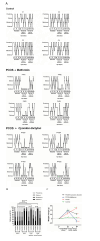Therapeutic Effects of Cynodon dactylon (C. dactylon) against Polycystic Ovary Syndrome Induced by Letrozole in Adult Rats: Ovarian and Uterine Aspects
- PMID: 40200779
- PMCID: PMC11976885
- DOI: 10.22074/ijfs.2024.2020015.1608
Therapeutic Effects of Cynodon dactylon (C. dactylon) against Polycystic Ovary Syndrome Induced by Letrozole in Adult Rats: Ovarian and Uterine Aspects
Abstract
Background: Cynodon dactylon traditionally employed or treating hormonal problems in women. Therefore, this study aimed to assess the effect of C. dactylon hydroalcoholic extract of on letrozole-induced polycystic ovary syndrome (PCOS) in adult rats.
Materials and methods: In this experimental study, hydroalcoholic extract was prepared from the whole plant except the root. Then, 16 female Sprague-Dawley rats were divided into four groups. In the control group, the PCOS model was not induced and no treatment was performed. The PCOS-induced groups received 1 mg/kg of body-weight letrozole daily by gavage for 21 days. In the PCOS-induced groups two groups were orally treated with 250 mg/kg body weight daily metformin or 500 mg/kg body weight daily C. dactylon extract, 28 days after PCOS induction. Hormonal, histopathologic, and histomorphometric analyses were performed. Molecular docking also done to evaluate effect of C. dactylon extract on receptors involved in the pathophysiology of PCOS.
Results: C. dactylon had a remarkable positive effect on estrous cycles and also led to a significant reduction in the weight of PCOS rats. Moreover, C. dactylon extract mitigates PCOS-induced hormonal imbalances including a significant decrease in testosterone and estrogen levels, as well as increased progesterone levels. Ovarian and uterine structures were improved including reducing theca layer thickness, enhancing antral follicular areas, and a significant decrease in the luminal area of the perimetrial layer, endometrial glands, and the total uterine area when compared to the PCOS group. Besides, molecular docking analysis showed that Ar-tumerone, Tumerone, Tricyclo[6.3.0.0(1,5)] undec-2-en-4-one, 2,3,5,9- tetramethyl, Curlone, and 3-Tert-butyl-4-hydroxyanisole showed the most binding affinity to the receptors that play crucial role in the pathophysiology of PCOS.
Conclusion: C. dactylon extract could display positive effects on both the ovary and uterus of letrozole-induced PCOS rats. Therefore, C. dactylon had therapeutic effects on the ovary and uterus of PCOS-induced rat models.
Keywords: Cynodon dactylon; Ovarian follicles; Polycystic Ovary Syndrome; Sex Hormones; Uterus.
Figures





Similar articles
-
Regulation of estrous cycle by Cynodon dactylon in letrozole induced polycystic ovarian syndrome in Wistars albino rats.Anat Cell Biol. 2019 Dec;52(4):511-517. doi: 10.5115/acb.19.114. Epub 2019 Dec 31. Anat Cell Biol. 2019. PMID: 31949991 Free PMC article.
-
Agaricus Subrufescens ameliorates ovarian dysfunction and regulates altered biochemical parameters in rats with Letrozole induced polycystic ovarian syndrome.J Ovarian Res. 2023 Nov 22;16(1):221. doi: 10.1186/s13048-023-01311-1. J Ovarian Res. 2023. PMID: 37993900 Free PMC article.
-
Novel promising reproductive and metabolic effects of Cicer arietinum L. extract on letrozole induced polycystic ovary syndrome in rat model.J Ethnopharmacol. 2021 Oct 5;278:114318. doi: 10.1016/j.jep.2021.114318. Epub 2021 Jun 7. J Ethnopharmacol. 2021. PMID: 34111539
-
Hydroalcoholic extract of flaxseed improves polycystic ovary syndrome in a rat model.Iran J Basic Med Sci. 2018 Jun;21(6):645-650. doi: 10.22038/IJBMS.2018.25778.6349. Iran J Basic Med Sci. 2018. PMID: 29942457 Free PMC article.
-
Ficus deltoidea ameliorates biochemical, hormonal, and histomorphometric changes in letrozole-induced polycystic ovarian syndrome rats.BMC Complement Med Ther. 2021 Nov 29;21(1):291. doi: 10.1186/s12906-021-03452-6. BMC Complement Med Ther. 2021. PMID: 34844580 Free PMC article.
References
-
- Joham AE, Norman RJ, Stener-Victorin E, Legro RS, Franks S, Moran LJ, et al. Polycystic ovary syndrome. Lancet Diabetes Endocrinol. 2022;10(9):668–680. - PubMed
-
- Hernández-Jiménez JL, Barrera D, Espinoza-Simón E, González J, Ortíz-Hernández R, Escobar L, et al. Polycystic ovarian syndrome: signs and feedback effects of hyperandrogenism and insulin resistance. Gynecol Endocrinol. 2022;38(1):2–9. - PubMed
LinkOut - more resources
Full Text Sources
Research Materials
